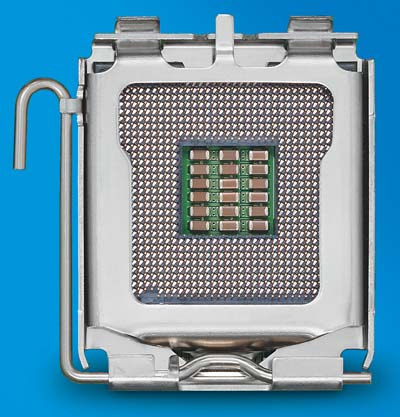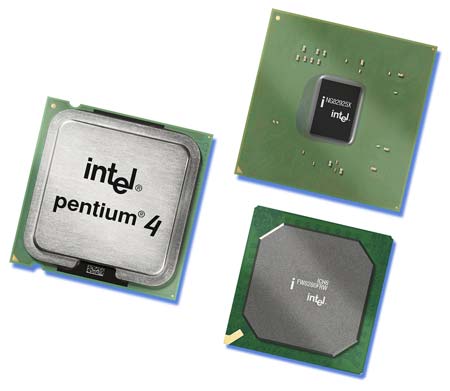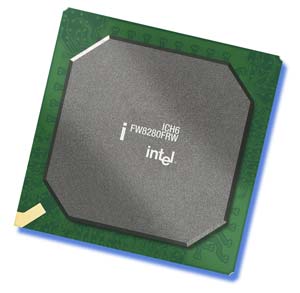Intel 925X/915: Chipset Performance & DDR2
by Wesley Fink on June 19, 2004 3:01 AM EST- Posted in
- CPUs
Intel Socket 775 Chipsets
You're looking at the new 775-pin socket T, which reverses the Socket 478 by putting the pins in the socket on the motherboard. The 775 processor has no pins at all; it has 775 small 'cups' that make contact with the pins in the socket.
The new chipsets for Socket 775 range from the 925X at the top to a full range of mainstream 915 chipsets, both with and without the new Intel Integrated DirectX 9 graphics.

The 915/925X are updates to the current 865/875 chipsets, which will continue in the Intel line for the time being.
All of the new 775 chipsets are paired with the updated ICH6 Southbridge. The ICH6 integrates the new 24-bit 192kHz High-Definition Audio. Intel HD audio also features eight independent DMA audio engines. This can enable multiple separate, simultaneous audio streams.

The new Southbridge also supports four SATA ports, which double the available SATA ports from ICH5. The new SATA ports can support either hard drives or optical devices with hot plug capabilities and Native Command Queuing (NCQ). While the SATA support is still SATA 1 (150MB/s), Intel claims that the new NCQ feature allows faster boots and increases file transfer speeds.
As we first saw on 875/865 family, there is also an ICH6R that can be paired with the new Northbridge chips to provide Intel Matrix RAID capabilities. The new Matrix Raid supports RAID 0, 1, 0+1, and an interesting option that allows combining both mirroring for security and striping for speed using only two drives.
New for 925X/915 is a new "W" Southbridge for ICH6 that supports Intel Wireless Connect Technology. This is designed to simplify wireless networks and connections. The W option is available with the regular Southbridge as ICH6W, and with the Matrix RAID version, ICH6RW. Consider the "W" in ICH6W and ICH6RW a future feature, however, because Intel does not yet have the wireless feature working. The accessory cards for wireless are not available at launch either.
The new Intel chipsets only support one IDE controller, so two IDE devices on the same channel is the only option for IDE. With SATA optical drives only just starting to appear, that means your IDE hard drive and optical IDE device will have to share a single channel. Even if you have SATA drives, your two IDE optical devices will have to share a single IDE channel. It is abundantly clear that Intel is trying to accelerate the move to SATA by limiting IDE options on the new chipsets.










57 Comments
View All Comments
gsellis - Saturday, June 19, 2004 - link
I am with #4 and #16, it is OK to leave the Northwood, but this is not apples to apples if you did not use two Prescotts to compare the boards to get a percentage difference in the architecture. The 'weak' areas almost match up to a Prescott vs Northwood comparison. It does not tell anything. Sorry Wesley, but the conclusion is flawed on a direct comparison.Bozo Galora - Saturday, June 19, 2004 - link
and notice the alderwood gigabyte only has the single red intel IDE, no greenieshttp://www.tomshardware.com/motherboard/20040619/i...
Bozo Galora - Saturday, June 19, 2004 - link
Tom's says new Intel chipsets are O/C locked - tied to PLLhttp://www.tomshardware.com/hardnews/20040619_1103...
Kahless - Saturday, June 19, 2004 - link
Am i missing something or is intel not as familiar with there own products as ATI...ie just read about ATI's chipset optimized for prescott and its faster than northwood which is a change from most benchmark comparisons on other boards ...http://www.anandtech.com/chipsets/showdoc.html?i=2...
ZobarStyl - Saturday, June 19, 2004 - link
Combined with the fact that they gonna start putting all this new tech on BTX format, Intel is really trying hard to completely remove itself from the DIY market. And although your average computer buyer doesn't even know what an AMD processor is, you can bet that OEM's are too happy about being asked to either a) swallow the cost of these upgrades or b) raise prices and lose customers, and this might make them eye AMD as a way to shore up the bottom line. Being a trendsetter is one thing but bringing in DDRII when it's slower and PCI-E when it offers practically no benefit isn't exactly blazing a trail that I want to follow...JustAnAverageGuy - Saturday, June 19, 2004 - link
"AMD is too pricey and Intel performance is pathetic"I can honestly say that is the FIRST time I have ever read that phrase.
Falloutboy525 - Saturday, June 19, 2004 - link
from what i've read on ddr2 it won't start make a big performance difference unless its clocked almost twice the speed as the ddr1 your compairing it to due to the fact all ddr2 is is 2 ddr1 chips dual channeld run thru a buffer. so when your running at 400mhz ddr2 the latency is the same as ddr200 due to the speed the chips are running at not the external frequency.Marlin1975 - Saturday, June 19, 2004 - link
"AMD is too pricey"WTF?
You can get a Athlon64 chip for less then $199 now and there is a sempron 3100+ socket 754 chip that has a MSRP of only $124
AMD hsa the best bang for the buck if you want low/mid end (atlon XP) or even mid/high end (Athlon 64/fx)
I went from a 800Mhz FSB HT P4 to a Athlon64 and and glad I did.
Zebo - Saturday, June 19, 2004 - link
"AMD is too pricey and Intel performance is pathetic"I agree socket 939 is way overpriced, especially for the underdog AMD who has an opporunity to make real enroads into the market with Intel down right now... but the rest of this is untrue. Socket 754 3200+ is the same price and P4 3.2 and they split the benchmarks. I'd argue for gamers the A64 3200+ is underpriced. Then intels performance is just fine unless you call 5-10% differences here and there signifigant. I don't and i doubt you'd even notice without charts to prove it.
tfranzese - Saturday, June 19, 2004 - link
"AMD performs great till you give it too much to do at once, and they won't fix that till they bring in dual core."Every processor is like this, Hyper-Threading doesn't save any Intel chip from this same thing. Benchmarks like Winstone, etc are benchmarking with multitasking in mind.
"AMD is too pricey and Intel performance is pathetic"
lol, it's ironic, but I'm glad AMD is where they are. They certainly aren't the same company there were 8 years ago.